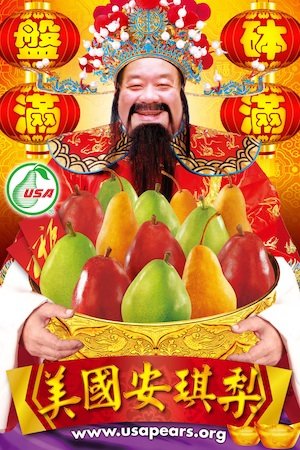
The Pear Bureau Northwest is distributing this framed God of Fortune poster to Chinese importers to demonstrate the profit opportunities for U.S. pears.
Courtesy Pear Bureau Northwest
Kevin Moffitt, president of the Pear Bureau Northwest, said 18 shippers in Washington and Oregon have signed up to export pears during the remainder of the 2012-2013 season, and he expects to see even more interest next year.
“We think China will crack the top-ten markets, probably within the first full season of shipping, next year, and we think it will easily reach 200,000 to 300,000 boxes within three years,” he said. The Pacific Northwest exports about 7 million boxes of pears annually, of which about half go to Canada and Mexico.
Moffitt expects China to become one of the largest export markets for red d’Anjou pears. Production of the variety has grown to a million boxes.
“It will be healthy to have an export market that can take potentially a tenth of the red d’Anjou crop,” Moffitt said. “It’s very exciting.”
The pear industry has been working with the Northwest Horticultural Council and the U.S. Department of Agriculture’s Animal Plant Health Inspection Service towards access in China for about 20 years. The U.S. government made its first official request for access in 1994. The breakthrough came when U.S. and Chinese negotiators hammered out an agreement during bilateral talks in California in September, 2012. It is a reciprocal agreement that allows China to ship sand pears into the United States. China already has access for its ya and fragrant pears.
China sent a letter to the U.S. government on January 21 confirming the immediate opening of the market, but Moffitt said it took a few days for the letter to be translated from Mandarin and the opening confirmed.
A number of measures in the orchard and packing house are required concerning fireblight, codling moth, and decay. Fireblight, which China says it does not have, was a sticking point for many years. Several years ago, U.S. scientists proved that mature, symptomless fruit do not carry the fireblight bacterium, which meant that the disease was unlikely to become established there as a result of importing U.S. pears. In order to ship fruit, packing houses need to be registered with USDA-APHIS, which will provide the list to the Chinese government. The Pear Bureau is handlling registrations this season.
Moffitt said Chinese importers have shown a lot of interest in U.S. pears. U.S. producers have been able in the past to ship pears to Hong Kong, which is the eighth largest export market and growing. Shipments during the 2011-2012 season totalled 131,000 boxes, up about 30 percent from the previous year. Moffitt said it’s suspected that some of the fruit is transshipped into China.
The Pear Bureau, which promotes Northwest pears under the USA logo, has a representative in Hong Kong who has conducted consumer research in anticipation of the China market opening. The Bureau set aside funding for promotions, which for this season will consist mainly of outreach to importers who already handle Washington apples and in-store promotions with key retailers in the major cities of Shanghai, Beijing, and Guangzhou.
“If we get any major shipments in, we have funds to do sampling,” Moffitt said.
The United States allowed access to sand pears on the same date that the China market opened for U.S. pears. Moffitt said he did not expect the Chinese pears to have a huge impact on the domestic market, although they do have a niche. “They will certainly be getting some shelf space and will compete on the produce department shelves, but we think our exports to China will be much more of a positive impact.”

Leave A Comment